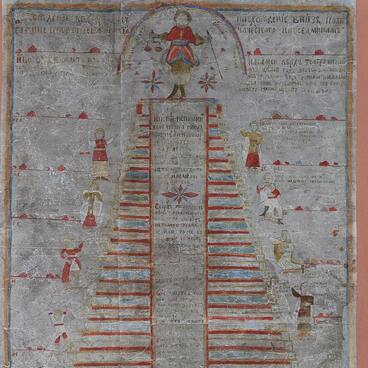The traditional costume of the Russian North necessarily included warm outerwear. It was sewn either from a thick woolen fabric or from fur.
Good-quality fur clothing has long been considered a sign of prosperity. It was an important part of a dowry and a wedding ceremony, such things were cherished, inherited and presented as a gift. The expensive clothes were bestowed on people for achievements in government service and included in diplomatic gifts, hence the Russian expression meaning “a fur coat from the Tsar”s shoulder”.
In medieval Ancient Rus, there were fur coats made of both sheepskin and more expensive furs — sable, marten, ermine, fox, polar fox. As a rule, old fur coats had fur on their inside. Sheepskin products often were not covered with fabric or were finished with simple materials such as linen or wool. Clothes made of more expensive furs, depending on the wealth of the owner, were covered with silk, velvet, or brocade. Forged buttons, lace stripes and embroidery were also found among the decorations.
In the 18th century, nobles, officials and rich merchants switched to clothes modeled on Western European ones. Clothing of the traditional type, which also included a fur coat, was common among peasants and poor townspeople.
Judging by written sources and repository collections, sheepskin and squirrel fur coats were in use in the Kargopol region by the mid-19th — early 20th century. Professional tailors were engaged in their manufacture: they sewed both uncovered and fabric-covered products. Kargopol residents wore plain uncovered sheepskin coats on weekdays, while expensive clothes with fine factory cloth, sable or squirrel collar and rich decoration were worn on holidays. The trimming usually was along the edge of the upper flap and sleeves: tailors decorated them with contrasting fabric or more expensive fur.
The fur coat from the collection of the Kargopol History, Architecture and Art Museum belongs to the festive type of clothing. It consists of many squirrel skins sewn together. On top of the fur, the product is covered with blue-black factory cloth. The silhouette here is cut-off at the waist, with a wide skirt, which is arranged in small folds at the back and sides. The back has cord seams. Along the edge of the right flap and at the ends of the sleeves, a trimming of fox fur is visible. On the seamy side, a strong patterned ribbon with free ends is sewn on the back of the belt — it was tied in front at the waist. This way the heat was better preserved, and the embossed back of the fur coat fit tighter and looked more impressive.
Good-quality fur clothing has long been considered a sign of prosperity. It was an important part of a dowry and a wedding ceremony, such things were cherished, inherited and presented as a gift. The expensive clothes were bestowed on people for achievements in government service and included in diplomatic gifts, hence the Russian expression meaning “a fur coat from the Tsar”s shoulder”.
In medieval Ancient Rus, there were fur coats made of both sheepskin and more expensive furs — sable, marten, ermine, fox, polar fox. As a rule, old fur coats had fur on their inside. Sheepskin products often were not covered with fabric or were finished with simple materials such as linen or wool. Clothes made of more expensive furs, depending on the wealth of the owner, were covered with silk, velvet, or brocade. Forged buttons, lace stripes and embroidery were also found among the decorations.
In the 18th century, nobles, officials and rich merchants switched to clothes modeled on Western European ones. Clothing of the traditional type, which also included a fur coat, was common among peasants and poor townspeople.
Judging by written sources and repository collections, sheepskin and squirrel fur coats were in use in the Kargopol region by the mid-19th — early 20th century. Professional tailors were engaged in their manufacture: they sewed both uncovered and fabric-covered products. Kargopol residents wore plain uncovered sheepskin coats on weekdays, while expensive clothes with fine factory cloth, sable or squirrel collar and rich decoration were worn on holidays. The trimming usually was along the edge of the upper flap and sleeves: tailors decorated them with contrasting fabric or more expensive fur.
The fur coat from the collection of the Kargopol History, Architecture and Art Museum belongs to the festive type of clothing. It consists of many squirrel skins sewn together. On top of the fur, the product is covered with blue-black factory cloth. The silhouette here is cut-off at the waist, with a wide skirt, which is arranged in small folds at the back and sides. The back has cord seams. Along the edge of the right flap and at the ends of the sleeves, a trimming of fox fur is visible. On the seamy side, a strong patterned ribbon with free ends is sewn on the back of the belt — it was tied in front at the waist. This way the heat was better preserved, and the embossed back of the fur coat fit tighter and looked more impressive.



